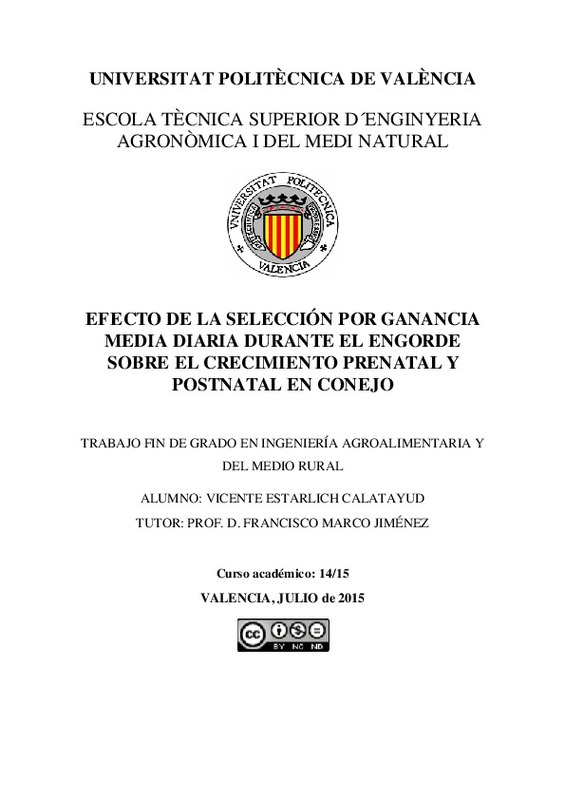JavaScript is disabled for your browser. Some features of this site may not work without it.
Buscar en RiuNet
Listar
Mi cuenta
Estadísticas
Ayuda RiuNet
Admin. UPV
Efecto de la selección por ganancia media diaria durante el engorde sobre el crecimiento prenatal y postnatal en conejo
Mostrar el registro sencillo del ítem
Ficheros en el ítem
| dc.contributor.advisor | Marco Jiménez, Francisco
|
es_ES |
| dc.contributor.author | Estarlich Calatayud, Vicente
|
es_ES |
| dc.date.accessioned | 2015-09-02T13:42:27Z | |
| dc.date.available | 2015-09-02T13:42:27Z | |
| dc.date.created | 2015-07-17 | |
| dc.date.issued | 2015-09-02 | es_ES |
| dc.identifier.uri | http://hdl.handle.net/10251/54197 | |
| dc.description.abstract | [ES] La vitrificación es una técnica de conservación de embriones, que hace posible la evaluación del efecto de la selección genética en la ganancia media diaria de peso, comparando poblaciones de la misma línea que se encuentran separadas en el tiempo, mediante la reconstitución de poblaciones. El objetivo de este estudio es reconstituir dos poblaciones de la línea Rosa de la Granja de Mejora Genética de la UPV, seleccionada por velocidad de crecimiento: una población control, de la cual se vitrificaron embriones de 72 horas en el año 1999 cuando se encontraba en la generación 25 y una población actual con embriones vitrificados también a 72 horas en 2014 encontrándose en la generación 36. Para ello se transferirán los embriones de cada una de las dos generaciones a 25 hembras de la línea Amarilla por tener estas mejores aptitudes maternales. Con esto se pretende obtener al menos quince orígenes vía macho de cada población para garantizar una baja consanguinidad en los posteriores cruces. A partir de los diez días de gestación, se realizarán ecografías cada dos días para llevar un seguimiento del crecimiento intrauterino de los fetos. A los catorce días se realizará una endoscopia para ver el número de implantados y posibles regresiones. Finalmente, los gazapos nacidos serán identificados con chips electrónicos para el seguimiento semanal de ganancia de peso individual. | es_ES |
| dc.description.abstract | [EN] From a long time ago, selection has been a tool used by the humanity to obtain offspring with interesting features from a productive point of view, including both animal and vegetable species. Currently, there are breeding programs of many species that use different selection methods to preserve the best individuals, in order to reproduce them and to be able to improve the lines. Due to the high genetic value that individuals achieve after years of selection and the possibility of its loss which could suppose a delay, banks of genetic material were established. In these banks, embryos are vitrified and stored in liquid nitrogen to -196OC. Therefore, this work has been carried out in order to evaluate the current vitrified embryos and those vitrified and stored 15 years ago from a rabbit line selected by daily average gain in the fattening period, of the Genetic Progress Unit in the UPV. In this work a total of 534 embryos were used, from two different generations of R line (18 and 36). From these 534, 301 were used as control (generation 36) and the 233 remaining as problem (generation 18). The results obtained showed that there were no significant differences in the post native growth up to the weaning, since both generations showed parallel and practically superposed growth curves. Nevertheless, there were significant differences in the prenatal growth, being the fetuses from the generation 36 longer than the generation 18. There were also differences in the time of storage of the embryos, since those from 18 generation, vitrified in 1999 showed less availability than those from generation 36, vitrified in 2014 and therefore a less cryopreservation efficiency. The above mentioned was favored by the loss of two straws that exploded during the warming procedure. | es_ES |
| dc.language | Español | es_ES |
| dc.publisher | Universitat Politècnica de València | es_ES |
| dc.rights | Reconocimiento - No comercial - Sin obra derivada (by-nc-nd) | es_ES |
| dc.subject | Embrión | es_ES |
| dc.subject | Conejo | es_ES |
| dc.subject | Nitrógeno líquido | es_ES |
| dc.subject | Selección | es_ES |
| dc.subject | Vitrificación | es_ES |
| dc.subject | Embryos | es_ES |
| dc.subject | Liquid nitrogen | es_ES |
| dc.subject | Rabbit | es_ES |
| dc.subject | Selection | es_ES |
| dc.subject | Vitrified | es_ES |
| dc.subject.classification | PRODUCCION ANIMAL | es_ES |
| dc.subject.other | Grado en Ingeniería Agroalimentaria y del Medio Rural-Grau en Enginyeria Agroalimentària i del Medi Rural | es_ES |
| dc.title | Efecto de la selección por ganancia media diaria durante el engorde sobre el crecimiento prenatal y postnatal en conejo | es_ES |
| dc.type | Proyecto/Trabajo fin de carrera/grado | es_ES |
| dc.rights.accessRights | Abierto | es_ES |
| dc.contributor.affiliation | Universitat Politècnica de València. Escuela Técnica Superior de Ingeniería Agronómica y del Medio Natural - Escola Tècnica Superior d'Enginyeria Agronòmica i del Medi Natural | es_ES |
| dc.contributor.affiliation | Universitat Politècnica de València. Departamento de Ciencia Animal - Departament de Ciència Animal | es_ES |
| dc.description.bibliographicCitation | Estarlich Calatayud, V. (2015). Efecto de la selección por ganancia media diaria durante el engorde sobre el crecimiento prenatal y postnatal en conejo. http://hdl.handle.net/10251/54197. | es_ES |
| dc.description.accrualMethod | TFGM | es_ES |
| dc.relation.pasarela | TFGM\28254 | es_ES |
Este ítem aparece en la(s) siguiente(s) colección(ones)
-
ETSIAMN - Trabajos académicos [3266]
Escuela Técnica Superior de Ingeniería Agronómica y del Medio Natural






